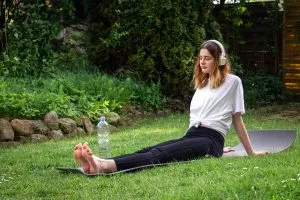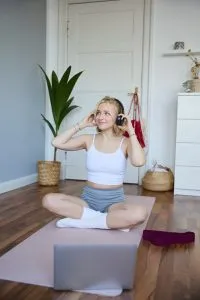Over the years, I’ve seen plenty of mats come and go. But now we want to find out everything there is to know about the best biodegradable yoga mats. I’ve got to tell you, the game has changed in recent years.
With our planet crying out for help, it’s high time we roll out mats that don’t just support our practice, but Mother Earth too.
So, let’s check out the best of biodegradable yoga mats and find out how we can strike a pose without striking a blow to the environment.
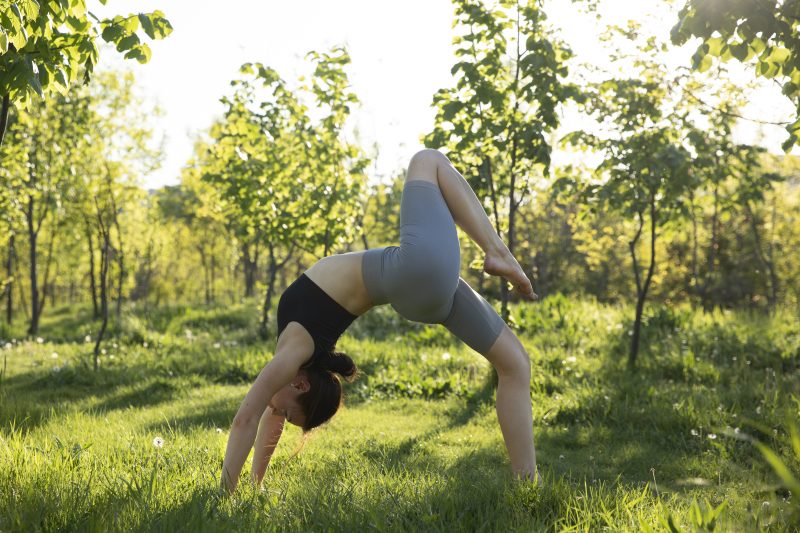
What is a Biodegradable Yoga Mat? (How I Tested)
Alright, let’s get down to it. A biodegradable yoga mat is exactly what it sounds like – a mat that’ll break down naturally over time instead of hanging around in landfills for centuries. But how do we know if a mat is truly biodegradable?
Well, I put these mats through their paces. I’m talking sun salutations, warrior poses, and even some hot yoga sessions to really test their durability. Then, I buried small samples in my garden (don’t worry, I asked the earthworms for permission first!) to see how they’d break down over time.
The key is to look for materials like natural rubber, cork, or organic cotton. These bad boys will eventually return to the earth without leaving a toxic trail behind. But remember, “biodegradable” doesn’t always mean “instant compost” – it can take months or even years for these mats to fully break down.
How Traditional Yoga Mats Harm the Environment and Your Health
Now, I hate to be a Debbie Downer, but we need to talk about our traditional yoga mats. You know, the ones that smell like a chemical factory when you first unroll them? Yeah, those aren’t doing us or the planet any favors.
Most conventional yoga mats are made from PVC (polyvinyl chloride), which is about as eco-friendly as a coal-powered SUV. These mats can take up to 1,000 years to decompose. That’s longer than it took for yoga to spread from ancient India to your local gym!
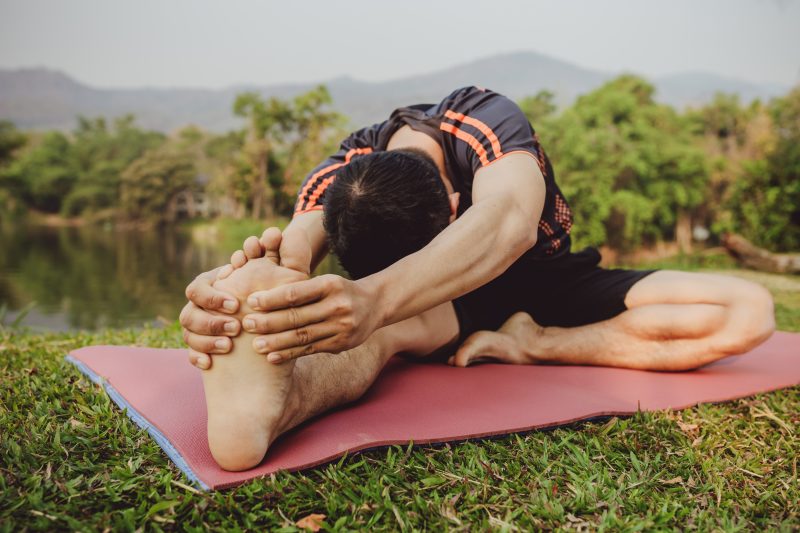
What Toxic Materials Are Found in Traditional Yoga Mats?
Brace yourselves, because this isn’t pretty. Traditional yoga mats often contain a cocktail of nasties:
- Phthalates: These are used to make the mat flexible, but they’re also endocrine disruptors. Not exactly what you want to be inhaling in downward dog.
- Heavy metals: Some mats contain lead and cadmium. Last I checked, “Lead Pose” wasn’t part of any yoga sequence.
- Formaldehyde: Yep, the same stuff used in embalming. It’s a known carcinogen.
- Chlorine: Used in PVC production, it can off-gas and irritate your lungs.
These chemicals don’t just stay in the mat. They can leach out onto your skin or evaporate into the air, especially when the mat heats up during your practice. Talk about toxic relationships!
My Favorite Biodegradable, Eco-Friendly & Non-Toxic Yoga Mats of 2025
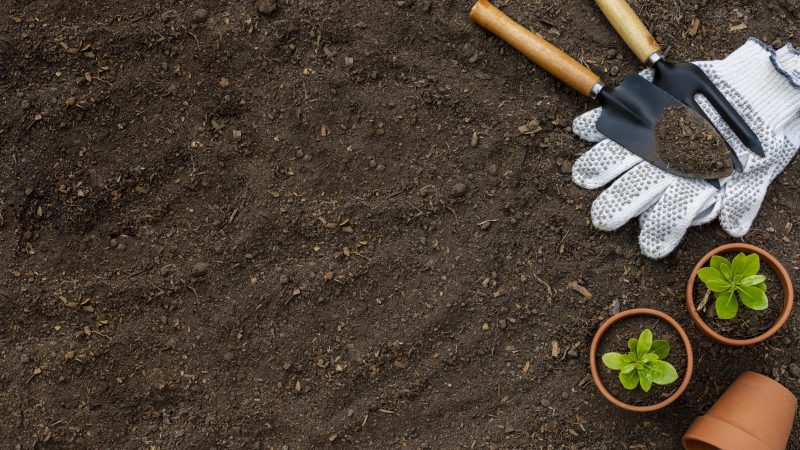
Alright, it’s time for the main event! Here’s my rundown of the top eco-friendly mats that’ll have you feeling good about your practice and your carbon footprint.
1. The Liforme Yoga Mat
Let me tell you, this mat is the cream of the crop. Made from naturally sourced sustainable rubber and eco-polyurethane, it’s biodegradable and recyclable. But what really sets it apart is the alignment markers. They’re like having a mini yoga instructor right there on your mat! Perfect for newbies and seasoned yogis alike.
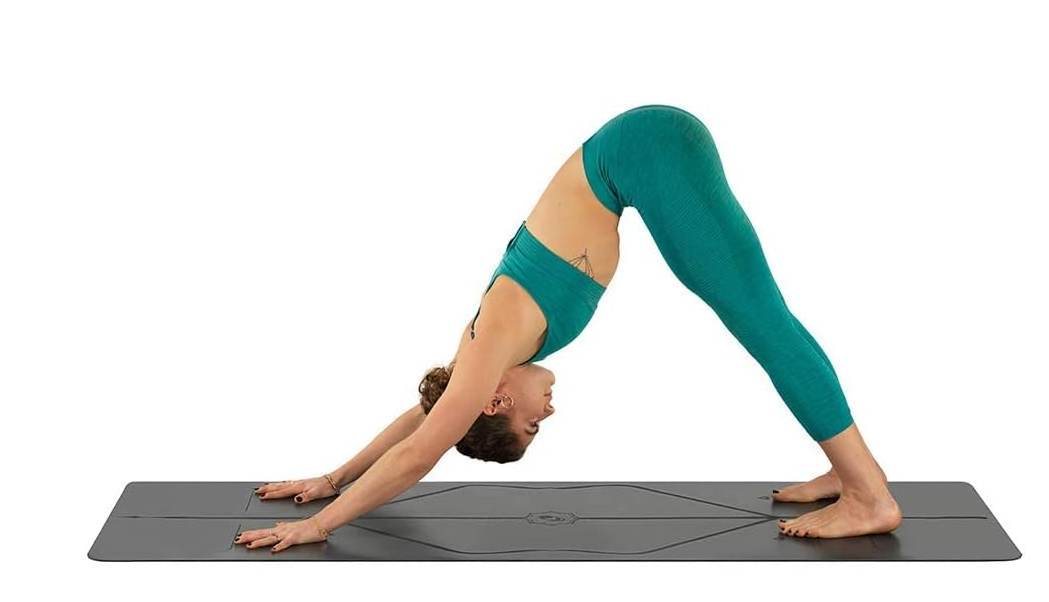
Liforme Original Yoga Mat
$149.95
- Patented Alignment System
- Warrior-like Grip
- Non-slip, Eco-friendly, sweat-resistant
- Long, wide, 4.2mm thick mat for comfort
2. Gaiam Yoga Mat
Gaiam’s been in the game for a while, and they’ve really stepped up with their eco-friendly options. Their natural rubber mats are biodegradable and free from those nasty PVCs and other toxic chemicals. Plus, they come in some pretty funky designs. Who says being eco-friendly can’t be stylish?
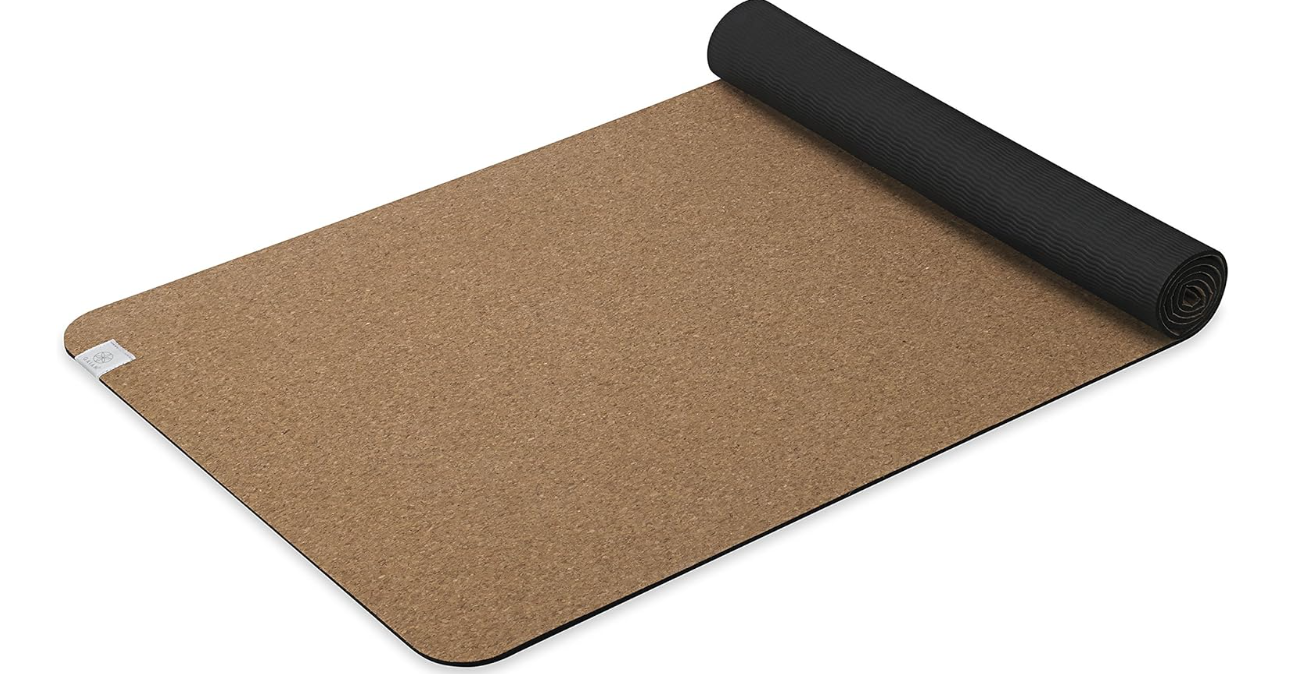
Gaiam Cork Yoga Mat
$29.97
- Natural Sustainable Cork Resists Germs and Odor
- Non-Toxic TPE Rubber Backing
- Great for Hot Yoga
- Dimensions are: 68-Inch x 24-Inch x 5mm Thick
3. Tranquil Yogi Tranquility Cork Yoga Mat
Now, if you haven’t tried a cork mat yet, you’re in for a treat. This mat from Tranquil Yogi is made from sustainably harvested cork and natural rubber. It’s naturally antimicrobial (goodbye, mat stink!), and it actually gets grippier when you sweat. Talk about a win-win!
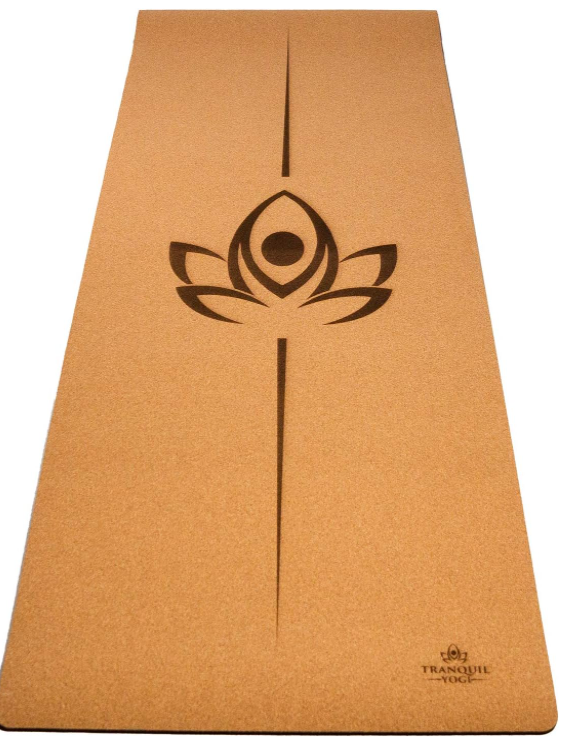
Tranquil Yogi Tranquility Cork Yoga Mat
$79.95
4. Jade Fusion Yoga Mat
Jade’s been walking the eco-friendly talk for years. Their Fusion mat is made from natural rubber tapped from rubber trees – a renewable resource. It’s thick, cushy, and perfect for those of us with creaky knees. Plus, they plant a tree for every mat sold. How’s that for karma?
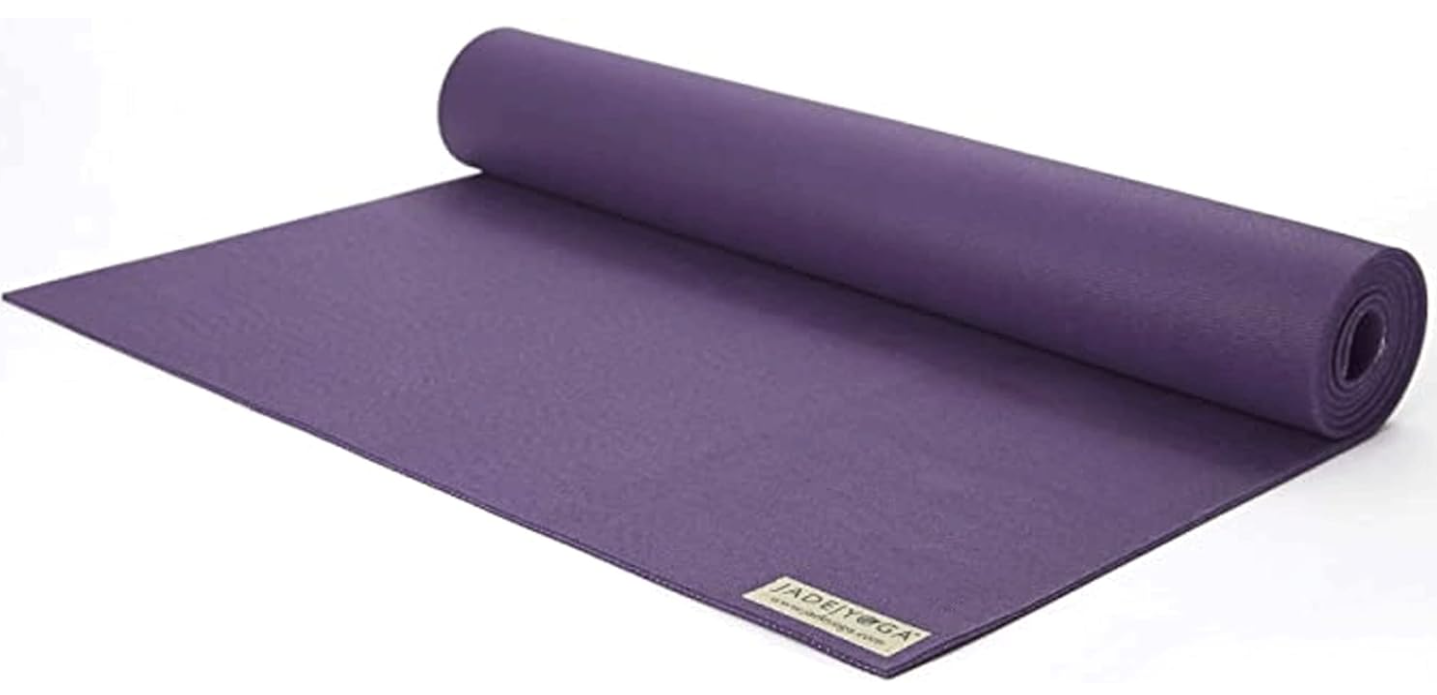
Jade Fusion Yoga Mat
$144.95
- Luxurious Comfort & Sturdy Workout Mats for Home Gym
- 68″ and 74″ Yoga Mat Thick
- Non-Slip Workout Mat with Extra Strong Grip
- US Made Yoga Mats
5. Luxury Cork Yoga Mat
Another cork option, this mat is the Rolls Royce of yoga mats. It’s thick, durable, and looks like a million bucks. The cork surface is naturally slip-resistant and antimicrobial, while the rubber bottom gives you stability. It’s a bit on the heavier side, but hey, consider it part of your strength training!
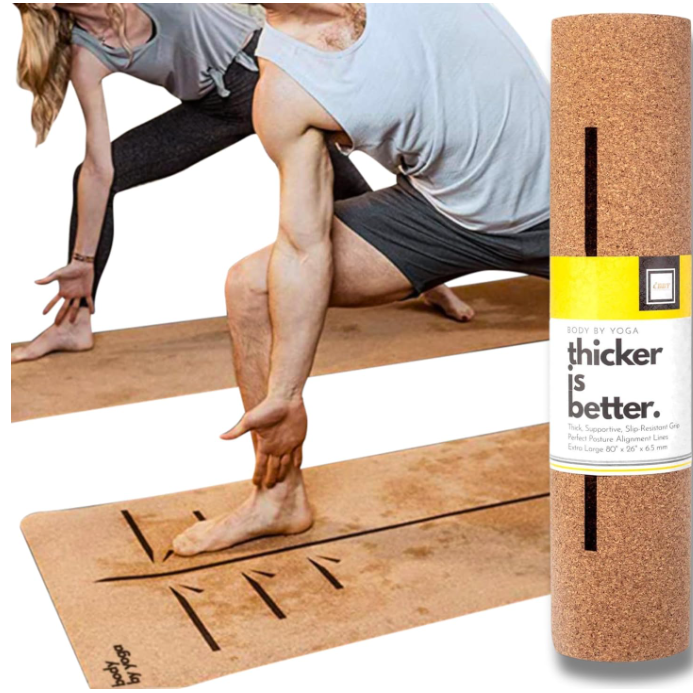
Luxury Cork Yoga Mat
$89.99
- Created by yoga instructors
- Extra thick padding
- Non-Slip Grip
- Premium Portuguese Cork
- Large Yoga mat
- Unrolls and stays flat
6. Hugger Mugger Para Rubber Yoga Mat
Don’t let the name fool you – this mat means business. Made from 100% natural rubber, it’s biodegradable and provides excellent grip. It’s a bit heavier than some other options, but that extra weight means it stays put during even the most vigorous vinyasa flow.
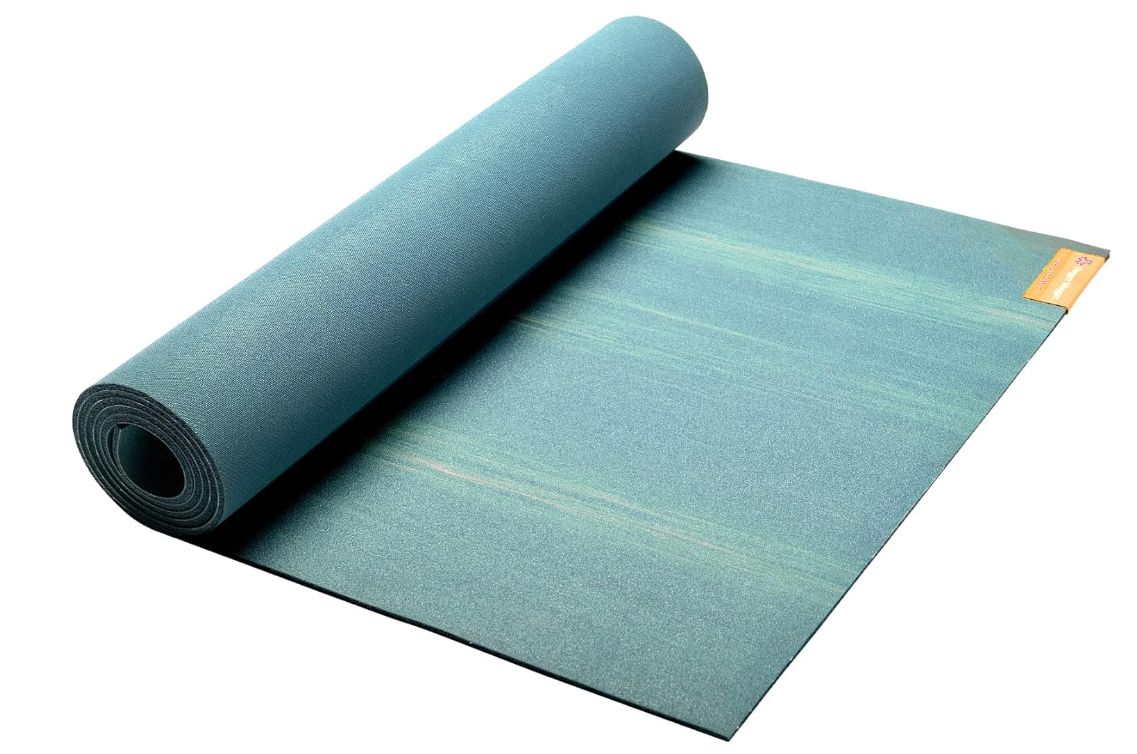
Hugger Mugger Para Rubber Mat
$99.95
- Superior, non-slip grip on both sides
- Natural rubber is durable, and long-lasting
- 1/4″ thickness with excellent cushion and shock absorption
- Streaked with a blue and green pattern
- Rubber is a natural, sustainable, renewable material. Ours comes from non- sources.
- Nonslip surfaces on both sides
- 1/4″ thickness for excellent cushion
7. Jade Harmony Yoga Mat
Another gem from Jade, the Harmony mat is like the Goldilocks of yoga mats – not too thick, not too thin, just right. It’s made from natural rubber and provides great traction. Plus, it comes in a rainbow of colors to suit every style.
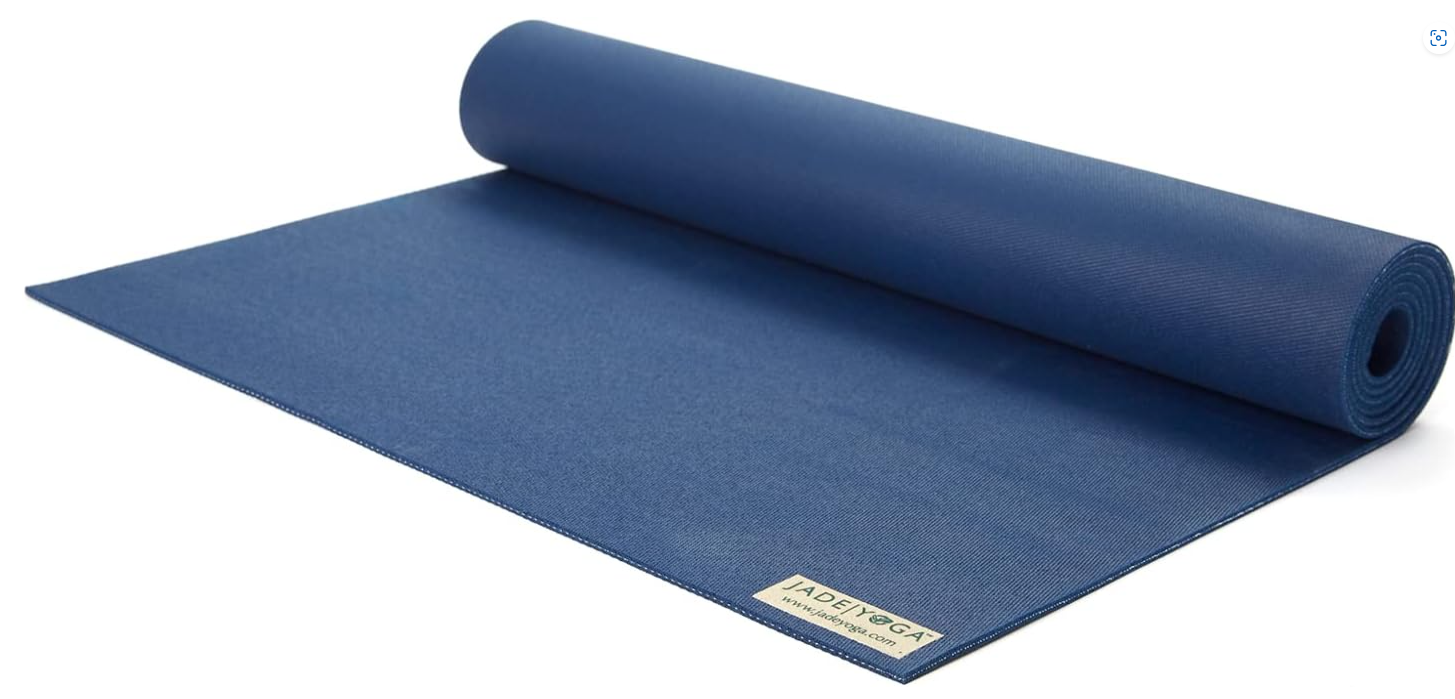
Jade Harmony Yoga Mat
$81.53
- Durable & Thick Gym Fitness Mat
- Non-Slip Natural Rubber Yoga Mat
- Home Exercise & Stretching Mat
- Workout Mat – Yoga
- Pilates & Meditation for Women & Men
8. Hugger Mugger Sattva Jute Yoga Mat
For those looking for something a little different, this jute mat is a great option. Jute is a sustainable, biodegradable fiber that gives you a unique texture to practice on. It’s backed with natural rubber for grip, making it a great eco-friendly alternative.
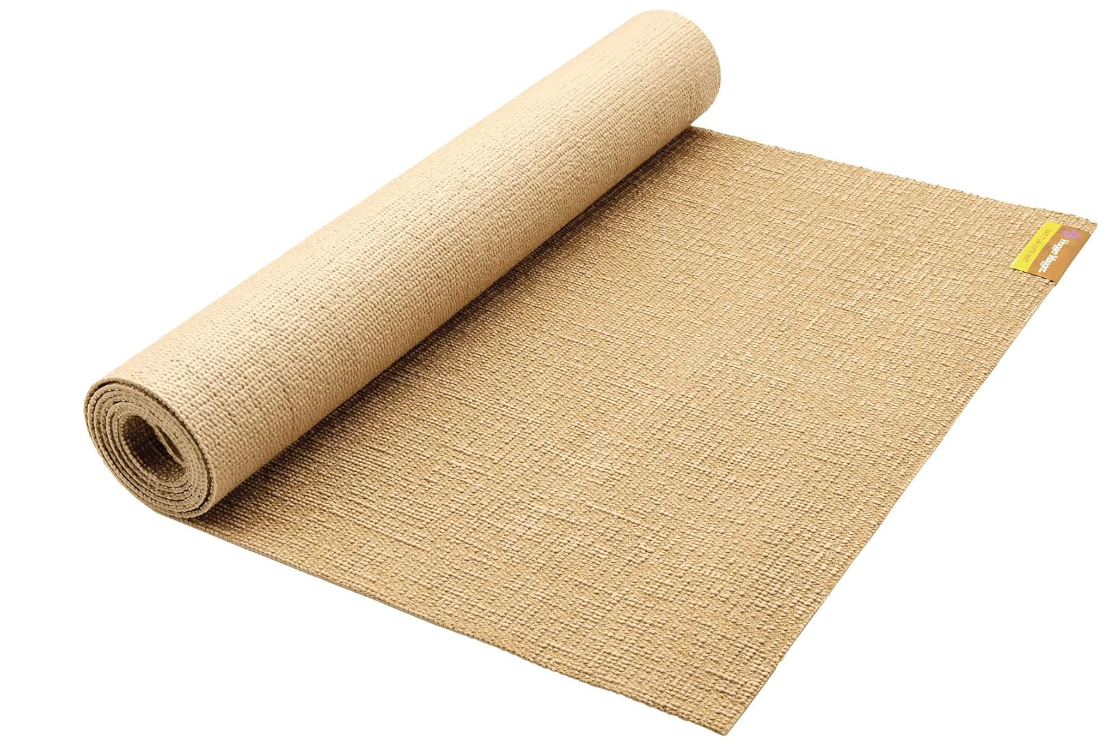
Hugger Mugger Sattva Jute Mat
$54.95
- Natural jute and non-slip per combine to make this mat Stable, Strong and sustainable
- 1/8 inch thickness cushions your bones and joints
- Lightweight, easy to Transport at only 2. 65lbs
- Outstanding grip and moisture absorption, great for hot yoga (bikram)
- Jute is a natural fiber plant that takes only four to six months to mature
9. Jade Level One Yoga Mat
If you’re new to yoga or looking for a more budget-friendly option, the Jade Level One is a great choice. It’s thinner than some other mats, but still provides good cushioning and grip. And like all Jade mats, it’s made from sustainable natural rubber.
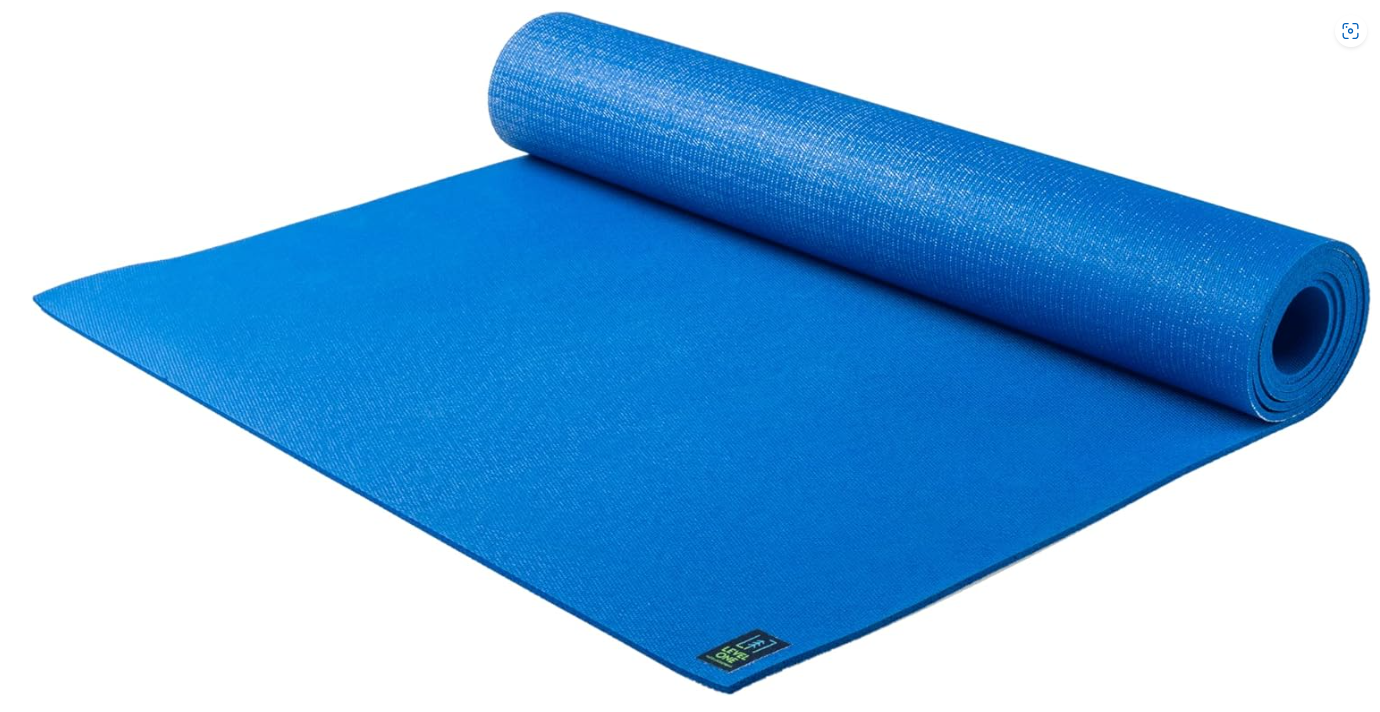
JadeYoga Level One Yoga Mat
$49.95
- Secure Grip
- Comfortable & Durable Exercise Mat for Beginners
- Portable Padded Mat
- Fitness Mat for Yoga, Pilates, Stretching, Home Workout and More
10. Hugger Mugger Earth Elements Yoga Mat
Last but not least, this mat combines natural rubber with jute fiber for a unique, eco-friendly option. It’s durable, provides good grip, and has a lovely earthy feel to it. Perfect for grounding your practice!
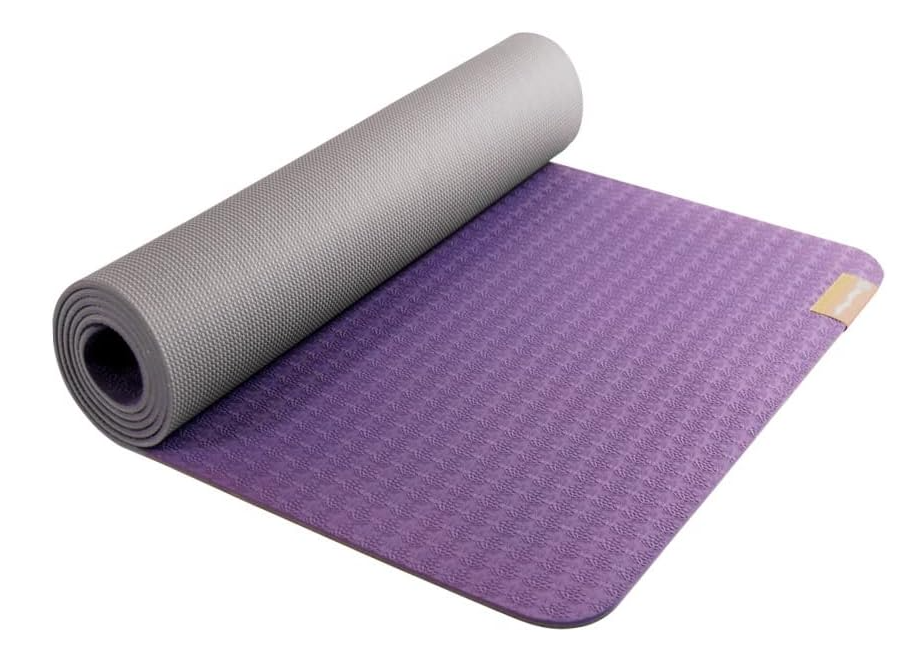
Hugger Mugger Earth Elements Yoga Mat
$62.95
- Nontoxic TPE is healthy for you and the planet
- Outstanding grip and cushioning
- Very lightweight, perfect for travel
- Recyclable
- Patterned surface with fun colors
- Latex-free
Whew! That’s a lot of mats, huh? But trust me, each one has its own unique qualities. Remember, the best mat for you is the one that feels right under your feet (or hands, or head, depending on the pose!).
Alright, let’s keep this yoga train rolling! Now that we’ve covered the good stuff, let’s talk about what to steer clear of and answer some burning questions.
What not to buy
Listen up, yogis – not all that glitters is gold, and not all that’s labeled “eco-friendly” is actually good for the environment. Let’s break it down.
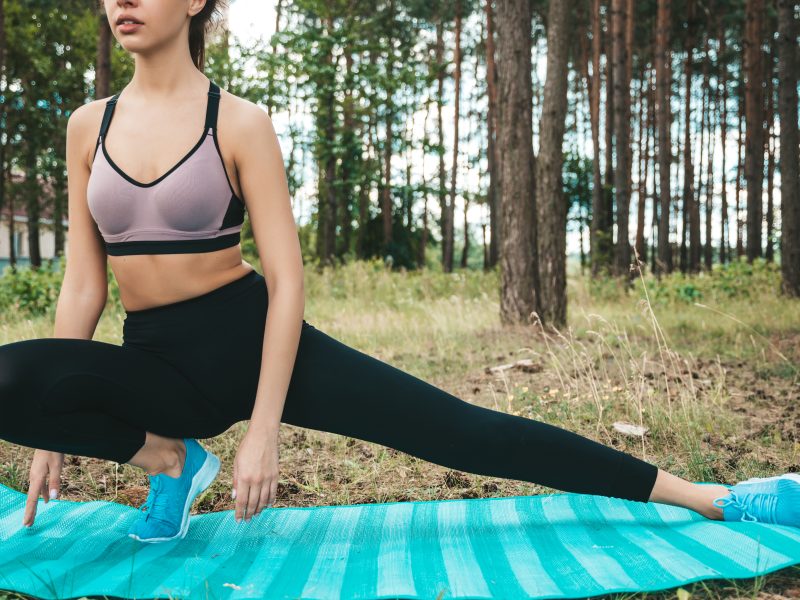
Are Rubber Yoga Mats Biodegradable?
Here’s the deal: natural rubber mats are biodegradable, but synthetic rubber? Not so much. It’s like comparing apples and, well, plastic apples. Natural rubber comes from trees and will break down over time. Synthetic rubber, on the other hand, is about as biodegradable as your grandma’s tupperware. So, always check if it’s natural or synthetic rubber before you buy.
Is Resin Bad for The Environment?
Ah, resin – the yoga mat world’s frenemy. Some resins are natural and eco-friendly, while others are about as green as a parking lot. Natural resins from plants? Thumbs up. Synthetic resins made from petroleum? Big ol’ thumbs down. They’re not biodegradable and can release nasty chemicals. Always check what kind of resin is used in your mat.

Is There a Chemical-Free PVC?
Short answer? Nope. It’s like asking for sugar-free sugar. PVC is a synthetic plastic that requires chemicals to produce. Even so-called “eco-friendly” PVC still contains chemicals that aren’t great for you or Mother Earth. My advice? Just say no to PVC mats altogether.
Is TPR Toxic?
TPR, or Thermoplastic Rubber, is like that friend who’s not terrible, but not great either. It’s less toxic than PVC, sure, but it’s still not biodegradable. Plus, it can contain phthalates and other chemicals. If you’re going for truly eco-friendly, there are better options out there.
Is Silicone Eco-Friendly?
Silicone is a bit of a mixed bag. It’s more durable and less toxic than many plastics, which is good. But – and it’s a big but – it’s not biodegradable. It’ll be hanging around in landfills long after your great grandkids have mastered their headstands. So, while it’s not the worst option, it’s not winning any green awards either.
Can you recycle yoga mats?
Now here’s a question I get a lot. The answer? It depends. Natural rubber and cork mats? Totally biodegradable. But recycling them can be tricky since they’re often mixed materials. Some companies, like Jade and Manduka, have recycling programs for their mats. For other mats, check with your local recycling center. And remember, the most eco-friendly mat is the one you use for years and years!
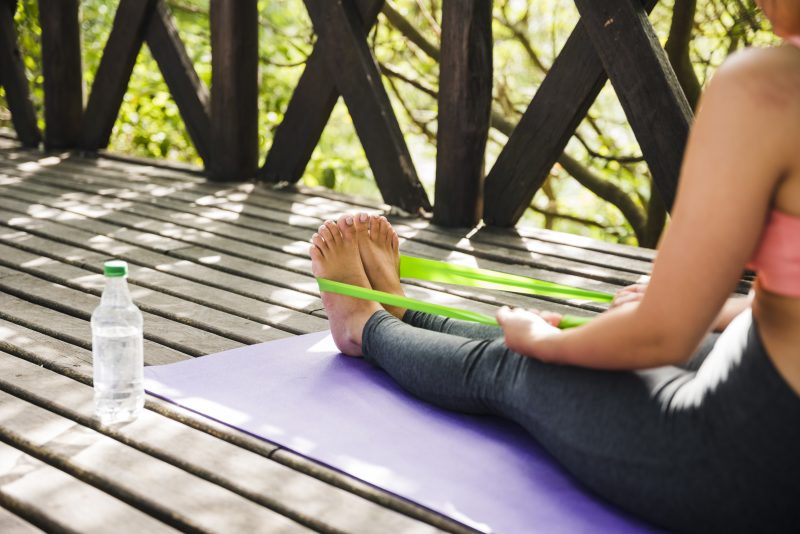
Cork: A sustainable and non-toxic yoga mat
Let me sing the praises of cork for a moment. This stuff is amazing! It’s sustainable (harvested from the bark of cork oak trees without harming them), naturally antimicrobial, and provides great grip. Plus, cork mats often have a natural rubber backing, making them fully biodegradable. They’re like the superhero of the yoga mat world!
Non-toxic and sustainable yoga mat brands
We’ve covered some great options already, but let’s give a shout-out to some brands really walking the eco-friendly talk:
- Jade Yoga: Pioneers in natural rubber mats
- Manduka eKO series: Natural rubber mats with no toxic chemicals
- Yoloha: Cork mats that are as beautiful as they are sustainable
- Scoria: Eco-friendly cork mats with gorgeous designs
- Korko: Another cork option with a focus on sustainability
Which of these options is the best yoga mat for hot yoga?
If you’re into hot yoga (and let’s face it, who doesn’t love a good sweat?), cork mats are your new best friend. They actually get grippier when wet, which is perfect for those steamy sessions. The Yoloha Native Cork mat or the Scoria Adult Cork Yoga Mat are fantastic options. If cork’s not your thing, the Jade Harmony mat holds up well in heat too.
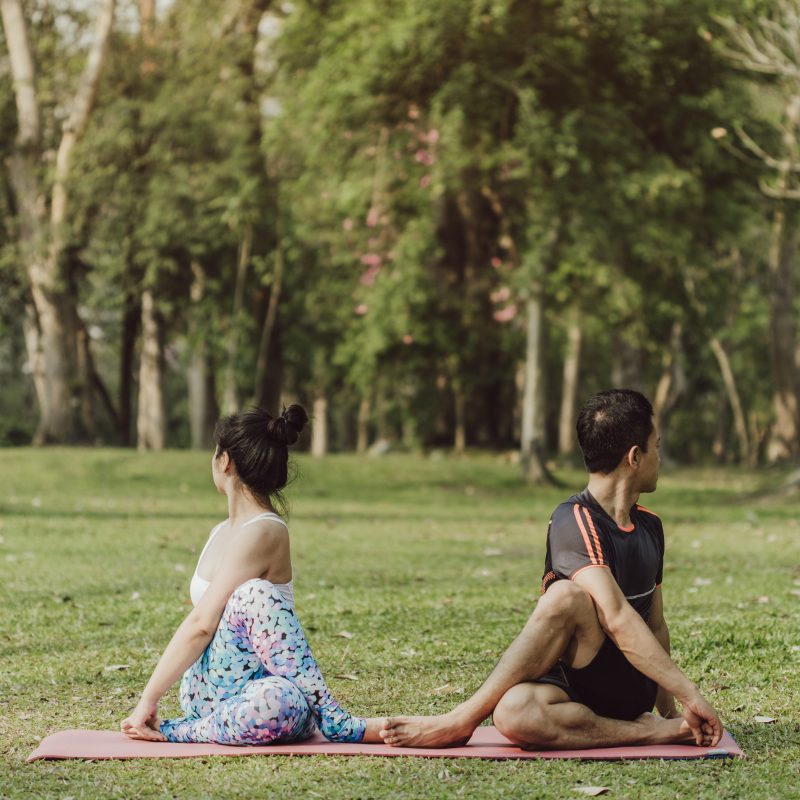
Which brand offers the best non-slip yoga mat?
For the slip-and-sliders out there (no judgment, we’ve all been there), I’d have to give the non-slip crown to Liforme. Their specially designed surface is like Velcro for your hands and feet. The Jade Fusion mat is a close second, especially if you prefer a thicker mat.
Awesome! Let’s roll out the FAQ section and tie this all together. Remember, these are questions I get all the time in my yoga classes, so don’t feel bad if you’ve been wondering about these too!
Frequently Asked Questions
How long do biodegradable yoga mats last?
Great question! It really depends on how often you practice and how well you care for your mat. On average, a good biodegradable mat should last you anywhere from 1-5 years. Remember, these mats are designed to break down eventually, so they won’t last forever – and that’s a good thing! Just think of it as an excuse to try out a new mat every few years.
Are biodegradable yoga mats as durable as traditional ones?
You bet they are! In fact, some of them, like cork mats, can be even more durable than their synthetic counterparts. The key is to choose a high-quality mat and take good care of it. Think of it like your favorite pair of yoga pants – treat ’em right, and they’ll stick with you through countless sun salutations.
How do I clean a biodegradable yoga mat?
Easy peasy! Most biodegradable mats can be cleaned with a mixture of water and mild soap. For cork mats, a solution of water and a few drops of tea tree oil works wonders (bonus: it smells great too!). Always air dry your mat and avoid leaving it in direct sunlight for long periods. And please, for the love of all things yoga, no washing machine adventures!
Are biodegradable yoga mats more expensive?
I’m not gonna lie – they can be a bit pricier upfront. But think of it as an investment in both your practice and the planet. Plus, many of these mats are super durable, so you won’t need to replace them as often. It’s like buying a reusable water bottle instead of disposable ones – more cost upfront, but better for your wallet (and the environment) in the long run.

Can I use a biodegradable mat for all types of yoga?
Absolutely! Whether you’re into gentle Hatha or power Vinyasa, there’s a biodegradable mat out there for you. Cork and natural rubber mats are great all-rounders. If you’re into hot yoga, look for a cork mat or a specially designed non-slip surface like Liforme’s.
What’s the best way to store my biodegradable yoga mat?
Think cool, dry, and rolled. Avoid leaving your mat in hot cars or damp basements. Roll it up when not in use (this prevents creasing), and store it in a breathable yoga mat bag if possible. Treat it like a fine wine – minus the drinking part, of course!
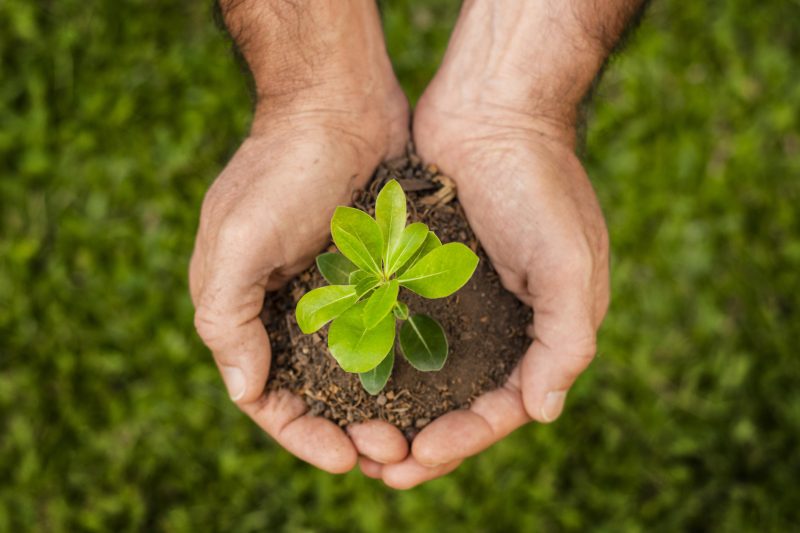
Are there any downsides to biodegradable yoga mats?
Look, nothing’s perfect – not even these eco-friendly beauties. Some people find natural rubber mats have a strong smell at first (it fades with time). Cork mats can be a bit heavier than synthetic ones. And yes, they might not last as long as a PVC mat. But in my book, the pros far outweigh the cons.
And there you have it, folks! Your complete guide to biodegradable yoga mats. Remember, every time you step onto one of these mats, you’re not just starting your yoga practice – you’re also taking a stand for our planet. So take a deep breath, strike a pose, and feel good about your eco-friendly choice.
Namaste, and may your practice be as green as it is serene!


